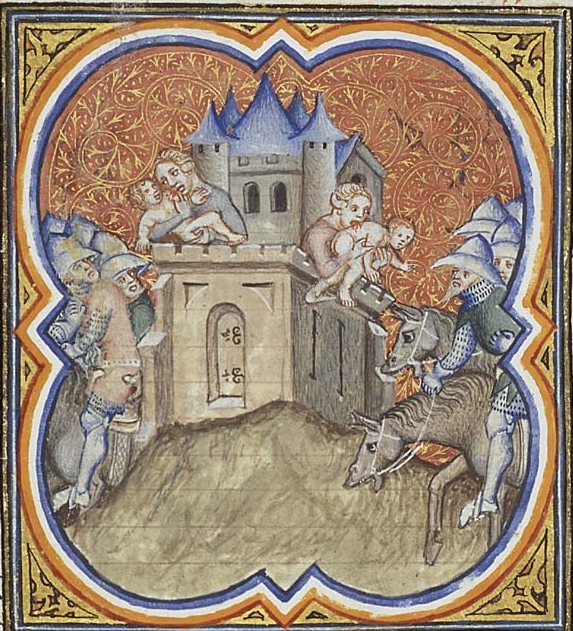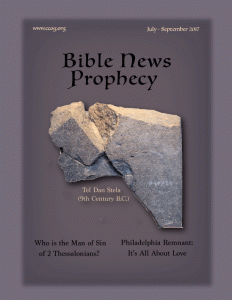‘Archaeologists find part of Jerusalem’s wall destroyed on Ninth of Av’

Artist’s conception of Nebuchadnezzar”s 587-586 BC siege of Jerusalem from 1372 (Wikipedia)
A reader sent me a link to the following:
Archaeologists find part of Jerusalem’s wall destroyed on Ninth of Av
In 586 BCE, the Babylonians breached the walls of Jerusalem and tore down the Temple, but part of the walls have survived, researchers discovered.
July 14, 2021
A section of Jerusalem’s city wall built during the First Temple period that was mostly destroyed by the Babylonian army in 586 BCE has been uncovered by archaeologists in the City of David National Park, the Israel Antiquities Authority said on Wednesday. …
The experts believe that when the Babylonians conquered Jerusalem, they might have not targeted the wall on the eastern slope because of the steep gradient but they did succeed in destroying the city and the Temple and sent the Jews into exile, similar to what would happen about 500 years later at the hands of the Romans. https://www.jpost.com/archaeology/archaeologists-find-part-of-jerusalems-wall-destroyed-on-the-9th-of-av-673794?_ga=2.178400108.950294608.1626076243-1969581575.1579377799&utm_source=ActiveCampaign&utm_medium=email&utm_content=Archaeologists+find+part+of+Jerusalem+s+wall+destroyed+on+9th+of+Av&utm_campaign=July+14%2C+2021+Day
The discovery of this wall should show naysayers that the Jews were in Jerusalem over 2400 years ago (some people have improperly claimed otherwise).
Now, here is a biblical reference related to that siege:
1 Now it came to pass in the ninth year of his reign, in the tenth month, on the tenth day of the month, that Nebuchadnezzar king of Babylon and all his army came against Jerusalem and encamped against it; and they built a siege wall against it all around. 2 So the city was besieged until the eleventh year of King Zedekiah. 3 By the ninth day of the fourth month the famine had become so severe in the city that there was no food for the people of the land.
4 Then the city wall was broken through, and all the men of war fled at night by way of the gate between two walls, which was by the king’s garden, even though the Chaldeans were still encamped all around against the city. And the king went by way of the plain. 5 But the army of the Chaldeans pursued the king, and they overtook him in the plains of Jericho. All his army was scattered from him. 6 So they took the king and brought him up to the king of Babylon at Riblah, and they pronounced judgment on him. 7 Then they killed the sons of Zedekiah before his eyes, put out the eyes of Zedekiah, bound him with bronze fetters, and took him to Babylon.
8 And in the fifth month, on the seventh day of the month (which was the nineteenth year of King Nebuchadnezzar king of Babylon), Nebuzaradan the captain of the guard, a servant of the king of Babylon, came to Jerusalem. 9 He burned the house of the Lord and the king’s house; all the houses of Jerusalem, that is, all the houses of the great, he burned with fire. 10 And all the army of the Chaldeans who were with the captain of the guard broke down the walls of Jerusalem all around.
11 Then Nebuzaradan the captain of the guard carried away captive the rest of the people who remained in the city and the defectors who had deserted to the king of Babylon, with the rest of the multitude. 12 But the captain of the guard left some of the poor of the land as vinedressers and farmers. 13 The bronze pillars that were in the house of the Lord, and the carts and the bronze Sea that were in the house of the Lord, the Chaldeans broke in pieces, and carried their bronze to Babylon. 14 They also took away the pots, the shovels, the trimmers, the spoons, and all the bronze utensils with which the priests ministered. 15 The firepans and the basins, the things of solid gold and solid silver, the captain of the guard took away. 16 The two pillars, one Sea, and the carts, which Solomon had made for the house of the Lord, the bronze of all these articles was beyond measure. 17 The height of one pillar was eighteen cubits, and the capital on it was of bronze. The height of the capital was three cubits, and the network and pomegranates all around the capital were all of bronze. The second pillar was the same, with a network.
18 And the captain of the guard took Seraiah the chief priest, Zephaniah the second priest, and the three doorkeepers. 19 He also took out of the city an officer who had charge of the men of war, five men of the king’s close associates who were found in the city, the chief recruiting officer of the army, who mustered the people of the land, and sixty men of the people of the land who were found in the city. 20 So Nebuzaradan, captain of the guard, took these and brought them to the king of Babylon at Riblah. 21 Then the king of Babylon struck them and put them to death at Riblah in the land of Hamath. Thus Judah was carried away captive from its own land. (2 Kings 25:1-21)
More and more we are seeing evidence supporting the biblical narrative. Secularists and secular scholars often discount and do not accept evidence that supports what the Bible says.
Yet, as we get closer to the end, archeologists continue to find more evidence of biblical locations, figures, and events.
Of course, for those of us who believe the Bible, no further archeological proof is needed. But for some who have heard statements from pseudo-archaeologists that deny the biblical accounts, it may be helpful for them to realize that as time goes on, more and more archaeological evidence surfaces that supports the Bible.
Here is a link to the July-September 2017 edition of Bible News Prophecy magazine. Its front cover shows an ancient stela that mentions King David, and contains more information about why true science supports the Bible.
Many secularist falsely claimed that King David was a myth, but the archaeological evidence says otherwise.
As far as the 586 destruction of Jerusalem goes, The Jewish Encyclopedia notes:
AB, NINTH DAY OF:
Day set aside by tradition for fasting and mourning, to commemorate the destruction of Jerusalem and the Temple by the Chaldeans (586 B.C.) and by the Romans (70); a movable fast falling approximately in the beginning of August of the Gregorian calendar. In II Kings, xxv. 8, 9 it is stated that the Temple was burned on the seventh day of the fifth month; in Jer. xxxix. 8 no exact date is given; while in Jer. lii. 12 the tenth day of the fifth month is assigned as the date. In connection with the fall of Jerusalem three other fast-days were established at the same time as the Ninth Day of Ab: these were the Tenth of Tebet, when the siege began; the Seventeenth of Tammuz, when the first breach was made in the wall; and the Third of Tishri, the day when Gedaliah was assassinated (II Kings, xxv. 25; Jer. xli. 2). From Zech. vii. 5, viii. 19 it appears that after the erection of the Second Temple the custom of keeping these fast-days was discontinued. Since the destruction of Jerusalem and of the Second Temple by the Romans, the four fast-days have again been observed. It has indeed been suggested that the sacredness of the day is due to its being the anniversary of the fall of Bethar at the end of the Bar Kokba war, thus making it a national rather than a religious ceremony.
In the long period which is reflected in Talmudic literature the observance of the Ninth Day of Ab assumed a character of constantly growing sadness and asceticism. Still it seems that, about the end of the second century or at the beginning of the third, the celebration of the day had lost much of its gloom. Judah ha-Nasi was in favor of abolishing it altogether or, according to another version, of lessening its severity when the feast has been postponed from Saturday to Sunday (Meg. 5b). A tendency to a less ascetic construction is also noticeable in the Talmudic explanation of Zech. viii. 19—namely, that the four fast-days would become feast-days during times of peace; on which Rashi remarks: “Peace means when the oppression of the Jews on account of their religion shall have ceased” (R. H. 18b). The growing strictness in the observance of mourning customs in connection with the Ninth Day of Ab is especially marked in post-Talmudic times, and particularly in the darkest period of Jewish life, from the fifteenth century to the eighteenth. ( Landsberg M, Kohler K. AB, NINETH DAY OF. The Jewish Encyclopedia of 1906. accessed 08/14/16)
We will see if this date may have future significance.
But for now, finding part of the wall that remained from the 586 destruction of Jerusalem is at least of archaeological and Old Testament interest.
Some items of possibly related interest may include:
Jerusalem: Past, Present, and Future What does the Bible say about Jerusalem and its future? Is Jerusalem going to be divided and eliminated? Is Jesus returning to the area of Jerusalem? There are also two related YouTube videos you can watch: Jerusalem To be divided and eliminated and God’s and Satan’s Plan for Jerusalem.
Biblical Archaeology This is a website that has more information on biblical archeological as is sometimes known as the Bib Arch site.
Who Gave the World the Bible? The Canon: Why do we have the books we now do in the Bible? Is the Bible complete? Are there lost gospels? What about the Apocrypha? Is the Septuagint better than the Masoretic text? What about the Textus Receptus vs. Nestle Alland? Was the New Testament written in Greek, Aramaic, or Hebrew? Which translations are based upon the best ancient text? Did the true Church of God have the canon from the beginning? Here are links to related sermons: Let’s Talk About the Bible, The Books of the Old Testament, The Septuagint and its Apocrypha, Masoretic Text of the Old Testament, and Lost Books of the Bible, and Let’s Talk About the New Testament, The New Testament Canon From the Beginning, English Versions of the Bible and How Did We Get Them?, What was the Original Language of the New Testament?, Original Order of the Books of the Bible, and Who Gave the World the Bible? Who Had the Chain of Custody?
 |
Tweet |
|
